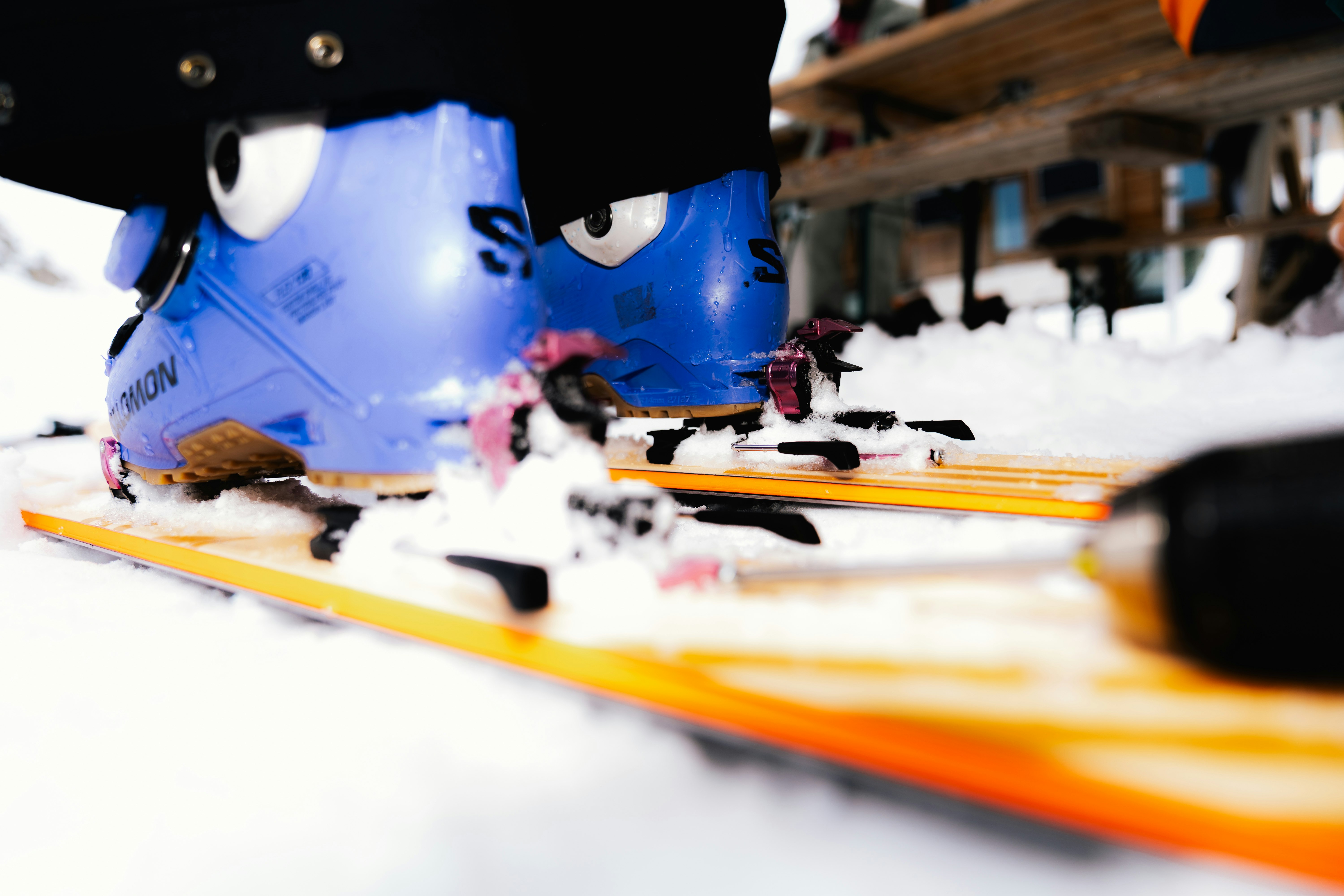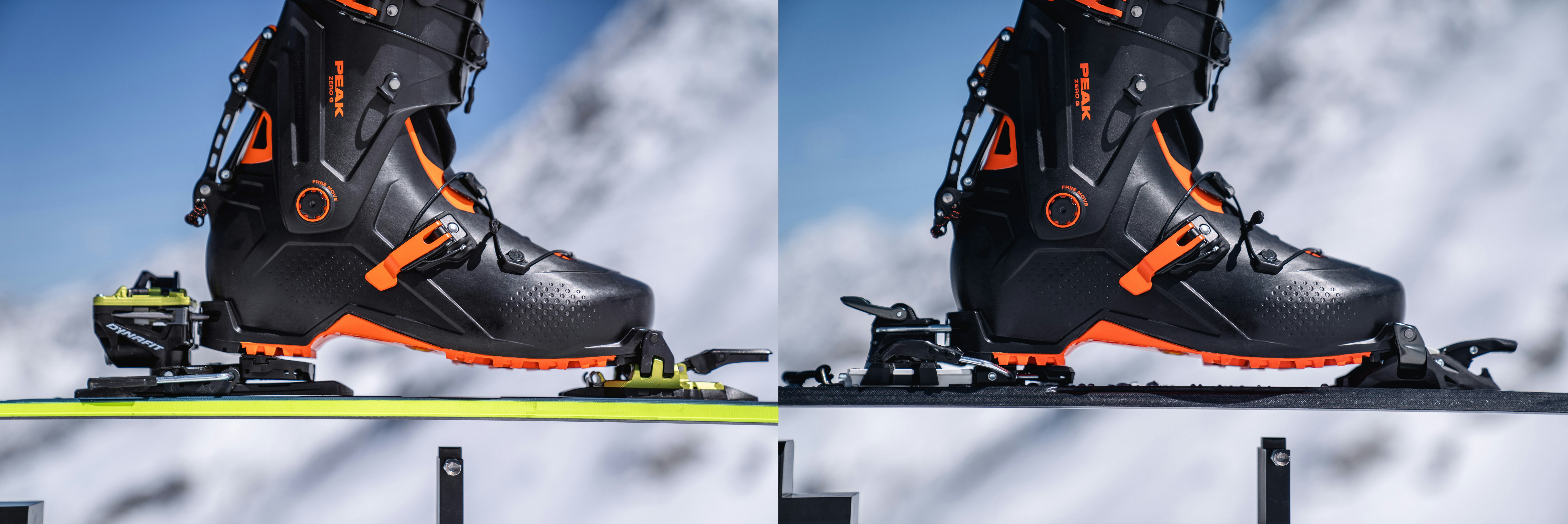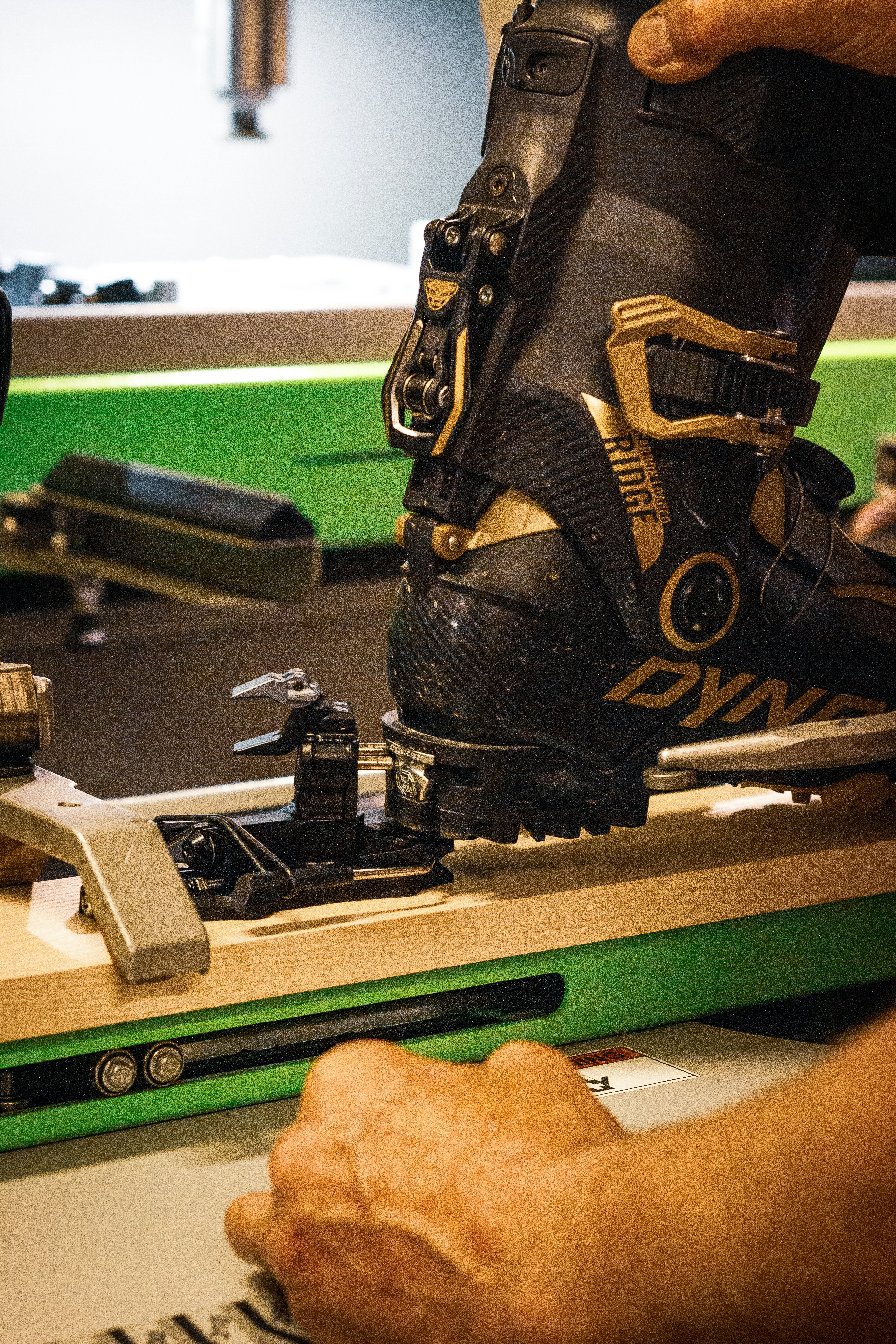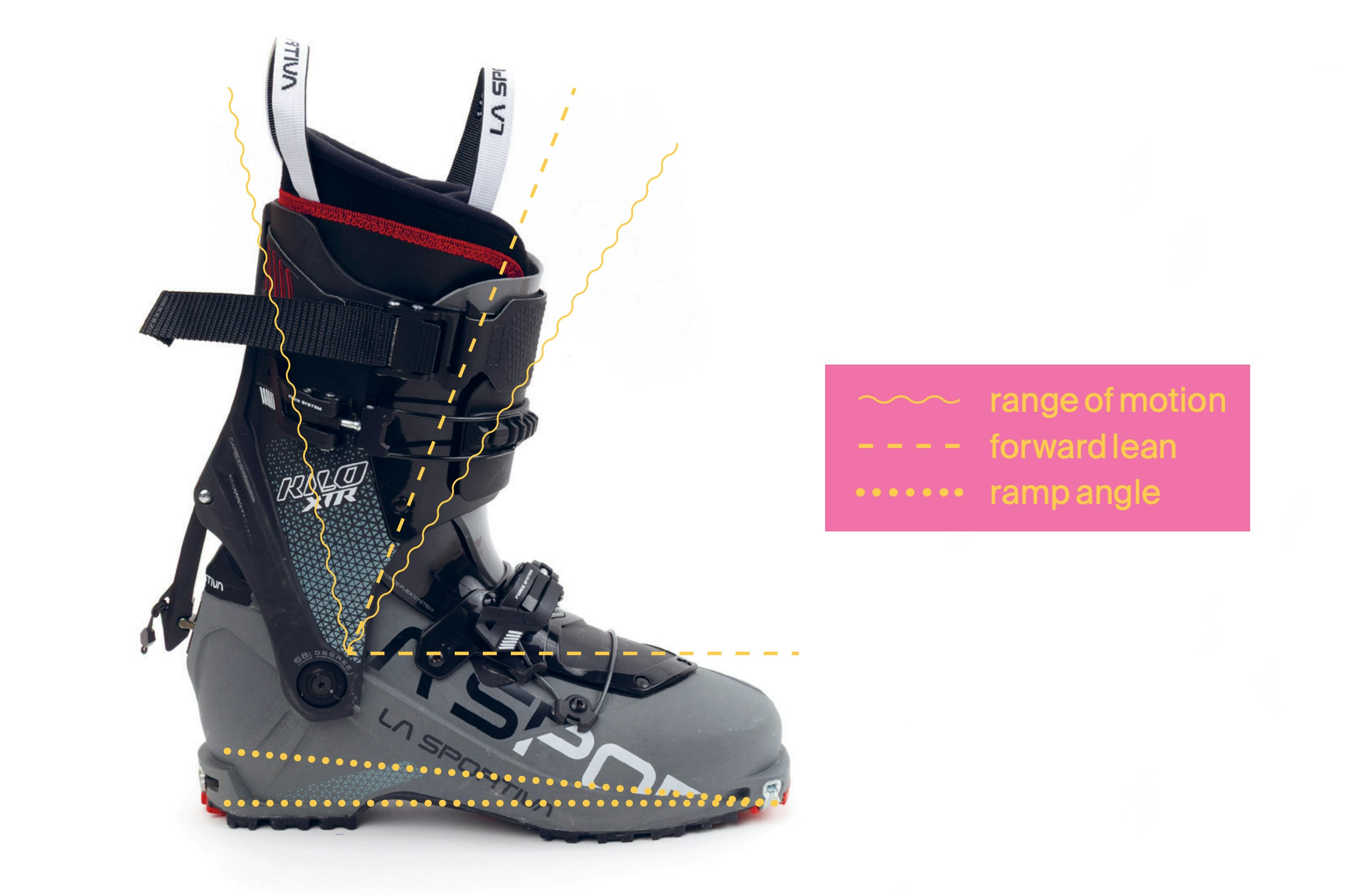Bindings: watch out for the drop
The drop, or delta, is the difference in height between the heel and toe; a figure that’s still all too variable between pin-system bindings, and an important factor in maintaining the correct stance when skiing. That’s why it’s important to consider the boot/binding pairing, as well as possible modifications
- Author: Guido Valota
- Photographer: Michele Guarneri
Alpine ski equipment is much more standardized and straightforward than its AT equivalent, and has been for many years. You can buy your gear without worrying too much about foot and ankle position; if you like you can adjust it a little with the cuff spoilers that come with your boots (until you realize it was better before). The boots have a flat sole and sit on the binding slider horizontally, as the housing in modern ski bindings is basically parallel to the footbed. The skier’s foot ends up slightly raised at the heel due to a single design feature—the ramp angle in the boot shell—which is set by the manufacturer, usually between 2 and 4°, depending on what kind of skiing the boot is for. The forward lean of the cuff is usually set at around 12° on race models, or slightly more on others, depending on factors like the end user, construction of the liner, flex and various measurements. This geometry has been arrived at after decades of development and creates a posture that facilitates motor responses and a centered stance during each dynamic phase and on all terrain. Of course, alpine skiers do sometimes adjust the foot/ankle position, but it comes down to individual requirements, and is carried out by specialists, who adjust the canting by barely a few tenths of a degree, and the ramp angle just a fraction more. Occasionally, specific training exercises call for a negative ramp angle to force the skier to modify their stance.
The same boot/binding geometry, and therefore foot position, also applies when skiing off piste; in fact, it’s more important, considering variable, uneven terrain is the norm, not the exception as it is on piste. The setup should be even more able to handle greater shocks than the skier will typically find on a smooth, groomed, even, predictable ski run. Therefore, the benchmark remains the delta of an alpine ski binding, as it has been properly developed under constant, replicable conditions. It’s no coincidence that in hybrid and full step-in hybrid models designed for committing backcountry terrain, the boot sits horizontally in the binding, staying perfectly level in multinorm models.

With the pin system, however, it’s still possible to find yourself with the wrong foot position, so you end up too far forward, or too upright. The problem with backcountry skiing is that there is still no completely universal, standardized delta for the boot/binding pin system, the most widespread in use today (the only real option for serious ascents). Where boots are concerned, you just need to look at the variety of soles and their rocker profiles, as well as the height of the metal inserts that house the binding pin; there can be up to 10 mm difference between different models of the same size. Ramp angle data also varies between boots, but at least stays within the range of 3.5–5°, or just over, among current tour and freeride models.
The situation is worse for bindings, as we can see from the measurements included in each spec sheet. The delta is the difference in height between the pins in the heel piece and those in the toe piece on the wing arms. Pin-system bindings vary by almost 20 mm between older designs (still on the market) at one end of the scale, and more recent models at the other. Even between models by the same brand. There are also bindings with a negative delta, especially among race models, which explains that involuntary backseat stance that makes almost any racer instantly recognizable. But even the delta on race bindings, which are so minimal to begin with, varies by up to 10 mm between models. In all the confusion surrounding boot/binding connection systems, pin-system deltas are still the most variable, and influential, factor in the position of the foot in the boot in ski mode. Up to a few years ago, this could be overlooked by changing posture and the effect wasn’t so pronounced, as boots in those days had basically no flex and were as padded as a pair of boxing gloves.

A short summary of the effect on the snow, all other factors being equal (in particular mounting and edge tuning)
- Too much delta = more load on the forefoot. Leads to sinking in deep snow, especially on thinner skis, tail wash on hardpack (where they actually skid and spin out, not just oversteer), and chatter.
- Insufficient or negative delta = less front loading. Leads to sitting back, less control in front, delayed turn entry, tendency to lose the outside ski, difficulty in releasing the turn, chatter.
Some of these effects can be corrected by well-trained skiers, at least partially, though not entirely, especially on uneven terrain or deep snow.

So how do you find the right foot position then? It’s doable.
Don’t worry, all is not lost. Some of the more creative binding models from the recent past have had their day, thanks to the market and the competition. Even the lineups of the most old-school brands feature fewer models with the old kind of heel unit. Maybe they’re still around, but the delta can be corrected by raising the toe piece with a spacer under the base, raising the boot on the ski, which isn’t good off piste, but on piste you can use it to your favor when on edge. So part of the problem is being rooted out at the source. Binding and boot manufacturers are talking to each other, at least the big names are, and delta is one of the subjects up for discussion. At the moment, however, the possible combination of all the measurements currently available remains infinite, also as older bindings are basically indestructible and are passed down from ski to ski. So luck and/or skill aren’t enough to get it right the first time (comparable to an alpine ski binding) without making some adjustments, even when you’ve put together your setup in a well-thought out, entirely rational way. But with a few minor tweaks, like a spacer under the heel, or using the spoilers that come with most boots, you can come close. In which case, your motor skills, through small proprioceptive adjustments (which are also part of the fun of tinkering with your gear), along with your setup’s elastic tolerance, will take care of the rest.

That’s the most important part over with; now you know about delta. Here are a few basic, yet practical, suggestions:
- Rule number one: go to a specialized dealer. Better still if they also offer servicing and bootfitting.
- Use a recent binding model with a delta of around 8–12 mm, except with boots very different from the size 27 average, or models with particularly flat (i.e. GripWalk) or very rockered soles.
- Small feet: try beforehand with a little less delta in the heel.
- Large feet: try beforehand with a little more delta in the heel.
- Too small a delta is fixable, add a spacer under the heel, where possible.
- Too much delta isn’t, at least not without some serious drawbacks.
- The forward lean in ski mode should be set only after finding an acceptable heel-toe delta. We know it’s usually the first thing you do because it’s the first thing that comes to mind, but on its own it doesn’t solve anything, in fact, it could even make things worse.
- Foot position modifications and forward lean should be set in a closed binding in ski mode.
- Any checks and tweaks you can do by skiing run after run on groomers (just buy a lift pass already). In case of any lingering doubts on the snow, ask a ski instructor, who’ll already have sized you up and can see straight away where the problem is.
- If you’ve done all the above but you still want to make some more adjustments, like adding three or four millimeters under the heel or increasing the forward lean beyond the maximum setting (not unusual), then there’s something wrong and it’s possible that the problem isn’t with the equipment.
So, if we haven’t managed to put you off touring entirely, have fun finding the right binding!
Share this article

